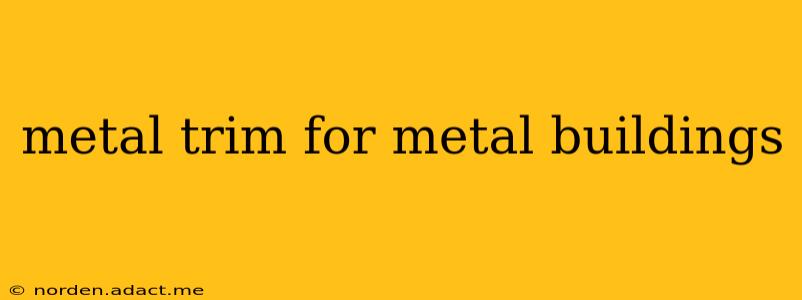Metal buildings, known for their durability and longevity, often benefit from the addition of metal trim. This finishing touch not only enhances the aesthetic appeal but also plays a crucial role in protecting the building's structure and extending its lifespan. This guide delves into the various aspects of metal trim for metal buildings, addressing common questions and providing valuable insights for homeowners, contractors, and building owners alike.
What are the different types of metal trim used for metal buildings?
The choice of metal trim largely depends on the specific needs and aesthetic preferences of the building owner. Common types include:
-
Aluminum Trim: Lightweight, corrosion-resistant, and available in a wide array of colors and finishes, aluminum trim is a popular choice for its versatility and relatively low cost. It's particularly suitable for applications where weight is a concern.
-
Galvanized Steel Trim: Known for its exceptional strength and durability, galvanized steel trim offers superior protection against rust and corrosion. Its robustness makes it ideal for high-traffic areas or harsh weather conditions.
-
Stainless Steel Trim: The premium option, stainless steel trim boasts unmatched resistance to corrosion and weathering. Its sleek, modern appearance and exceptional longevity justify its higher cost. Often preferred for applications demanding superior durability and a premium finish.
-
Copper Trim: While more expensive, copper trim offers a unique aesthetic appeal and exceptional longevity. Its natural patina develops over time, adding character and charm to the building. It's often chosen for its inherent beauty and resistance to corrosion.
What is the purpose of metal trim on a metal building?
Metal trim serves multiple critical functions:
-
Protection: It protects vulnerable areas of the building from the elements, preventing water damage, rust, and deterioration. This is particularly important at seams, joints, and edges.
-
Aesthetics: Trim significantly enhances the building's appearance, creating a more finished and polished look. It can add visual interest and improve curb appeal.
-
Structural Integrity: In some cases, trim contributes to the overall structural integrity of the building by reinforcing weak points or providing additional support.
How is metal trim installed on a metal building?
Installation methods vary depending on the type of trim and the building's construction. Generally, installation involves using screws, rivets, or specialized fasteners designed for metal-to-metal applications. Proper installation is crucial to ensure a watertight seal and prevent future problems. It's highly recommended to consult with a qualified installer for complex installations.
What are the benefits of using metal trim on metal buildings?
The advantages of using metal trim are numerous:
-
Durability: Metal trim is built to last, offering long-term protection and maintaining its appearance for years to come.
-
Low Maintenance: Unlike some other building materials, metal trim requires minimal maintenance, saving time and money in the long run.
-
Cost-Effective: While the initial investment might seem higher than some alternatives, the long-term cost savings associated with durability and low maintenance make it a cost-effective solution.
-
Aesthetic Versatility: A wide range of colors, finishes, and styles ensures that you can find the perfect trim to complement your building's design.
How much does metal trim cost for a metal building?
The cost of metal trim varies significantly depending on the type of metal, the length required, the complexity of the installation, and the chosen finish. Obtaining quotes from multiple suppliers is recommended to compare prices and ensure you're getting the best value.
What are some common problems associated with metal trim?
While generally durable, metal trim can encounter issues if not properly installed or maintained. Common problems include:
-
Corrosion: Improper sealing or exposure to harsh elements can lead to corrosion.
-
Loose or Damaged Fasteners: Over time, fasteners can loosen or become damaged, compromising the trim's integrity and waterproofing.
-
Improper Installation: Incorrect installation can result in leaks, gaps, and premature deterioration.
How can I maintain the metal trim on my metal building?
Regular inspection and cleaning are key to maintaining your metal trim. Cleaning can typically be done with soap and water, while more severe stains or corrosion may require specialized cleaning products. Regular inspection for loose fasteners or signs of damage can help prevent more significant problems.
This comprehensive guide provides a detailed overview of metal trim for metal buildings. Remember, selecting the right trim and ensuring proper installation are crucial for maximizing its benefits and protecting your investment. Always consult with qualified professionals for advice tailored to your specific building and needs.
